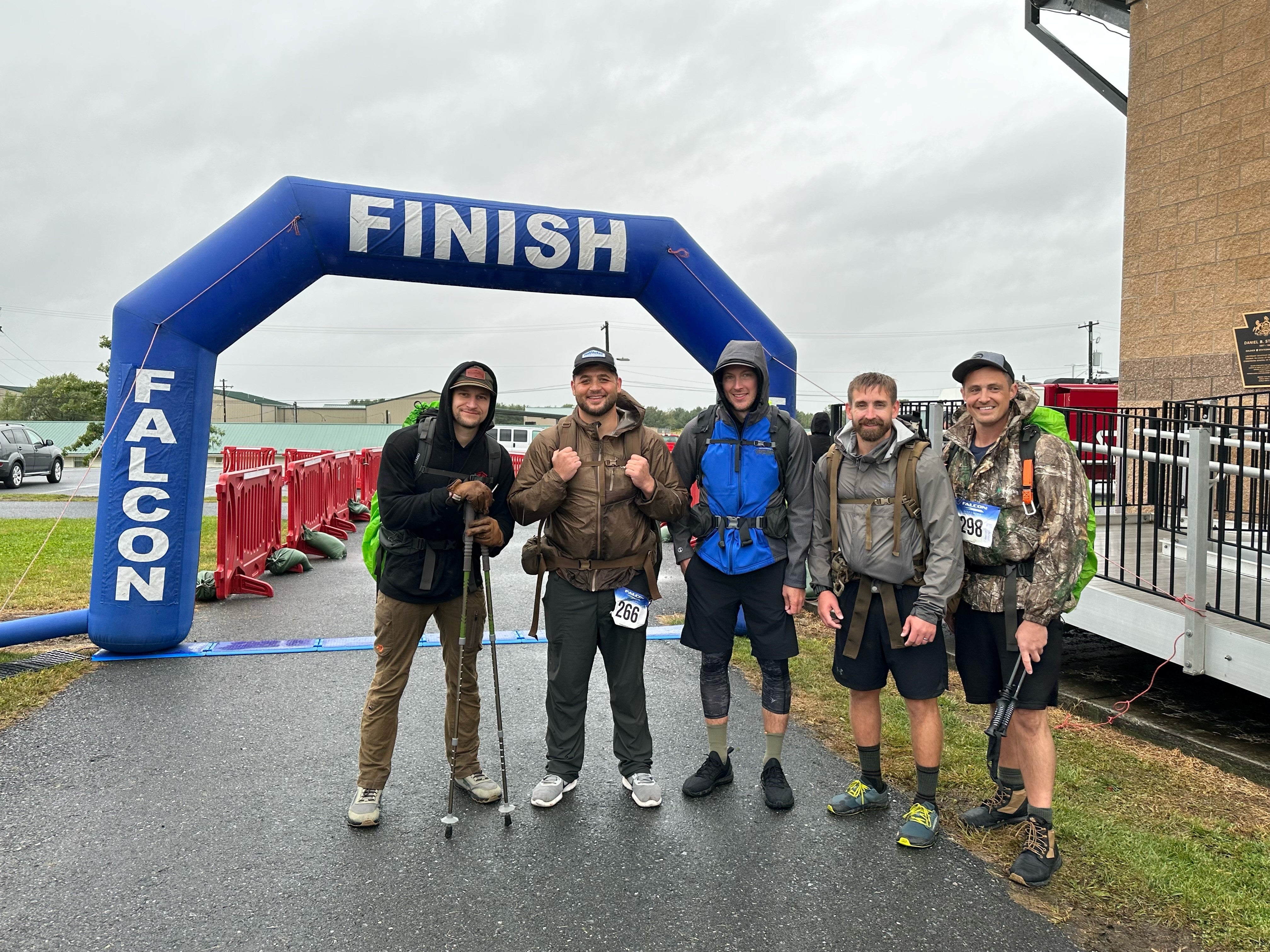Over the past handful of years, I’ve completed the 28-Mile March for the Fallen at Fort Indiantown Gap as a prelude to Pennsylvania’s archery season. The event comes at an ideal time—late September, so any training that I can get in during late summer, works in my favor as a double-dip to make sure that I don’t embarrass myself too much come time for backcountry hunts, pack-outs, and the rest of the outdoor toil that comes with messin’ around outdoors during the fall and winter. To top it off, this event is a good cause; the USO and the Pennsylvania Army National Guard Training Center host this event as a somber memorial for fallen service members who have made the ultimate sacrifice.
There are a handful of distances and classifications to choose from, but I was entered in the 28-Mile HEAVY. That’s a 28-mile ruck along what is essentially a perimeter route of Fort Indiantown Gap in central Pennsylvania. HEAVY implies that this is a ruck—that’s a loaded pack, weighing in at a minimum of 35-lbs.
I was as prepared as I was every other year leading up to this, but I’ll be honest, this year it really kicked my ass. Where I screwed up was overbooking my schedule that weekend and only getting 4 hours going into the event (I truly value sleep but sometimes this kind of thing is an inevitability).
Nature didn’t help a whole hell of a lot. This is a rain or shine event and the Northeast was getting hammered by Tropical Storm Ophelia: sustained winds over 35 miles per hour, flash flood advisories, all from the beginning of the ruck until well after we’d cross the finish line.
I completed the course, but barely. I got a ride from the finish line to my truck, I tried getting a coffee at a gas station on the way out of town and could barely walk the 25 feet to get to the coffee station, I used cruise control for as much of the drive as I could because it hurt to press or release the accelerator.... Really, it was embarrassing.
Fortunately, I have some protocols for dealing with this type of situation because this is precisely the conditions that I manage daily with athletes at my training facility in Northeastern PA. So today I have a breakdown for some of my methods for going from how physically debilitated I was on that Saturday evening at the finish line to where I was physically recovered enough to complete a strenuous workout on Monday.
Repair by Refueling
Stop #1 on the way home was gas station coffee, stop #2 was picking up a to-go order at a local restaurant for their prime rib dinner special. Chowing down on a fatty cut of meat after a physically exhaustive race, packout, or other endurance challenge is something that I’ve really homed in on this year.
If you’ve just packed-out an elk, you might be more inclined towards some heart or backstraps—and there’s certainly nothing wrong with that. Pound for pound wild game meat is some of the most protein rich food on the planet. But for the rest of us, a fatty cut of meat can provide some additional fat to help restore hormones, provide extra calories, and very generally expedite the recovery process.
As a nightcap that same evening, I had a full carton of Kettle & Fire Bone Broth. Continuing the recovery process through collagen supplementation is critical and the protein content within bone broth is comprised largely of collagen (if you have a bone broth which seems almost like a jelly when refrigerated or at room temperature, that jelly-like substance is almost entirely collagen).
If you’re running a vehicle or camper set-up for your hunt camp, you may even want to keep some bone broth handy. I’ll heat some up and sip it throughout the evening around the fire.
Collagen is one of the most important types of protein to consume, particularly after you’ve beaten up your body as badly as I did that weekend. I continued to consume bone broth diligently over the following 4 days and supplemented it with a collagen powder. Any kind of bovine collagen powder tends to do the trick and the beauty is you can mix it into almost anything without it altering the taste. I tend to throw collagen powder in hot drinks like coffee or mix it in with a more conventional whey protein shake or smoothie.
Red Light Therapy
Not that long ago I would’ve shrugged off Red Light Therapy as some hippy dippy nonsense that has no place in the confines of a human performance facility which prides itself on its respect for the scientific process. However, the body of evidence supporting Red Light Therapy is growing rapidly.
In the scientific literature, Red Light Therapy is usually referred to as Photobiomodulation. Our understanding of the mechanism and process behind this is still developing but essentially light is a crucial component for cellular function, the red light wave length has a greater propensity for penetrating deeper into the body (as it can penetrate through oxygen molecules, which is why sunrises and sunsets are red), and then normal biochemical processes can be expedited by the increased concentration of light at the mitochondria within the cell.
Red Light Therapy is even a common medical treatment with various Red Light devices approved as medical devices by the FDA. Red Light Therapy has been used for various medical conditions including chronic low back pain, wound healing, and even hair regeneration.
At my house I have a Hooga Health PRO300 - Red Light Therapy Panel which I used for about 10 minutes per day on some of the areas where I was feeling the ruck the most, notably my feet, my hips, and low back. If you don’t want to drop the money for a medical device, you may be surprised to learn that your gym (even some of the big box commercial gyms) may provide this onsite.
The conventional red-light procedure is 3 times per week 20 minutes total per session. I’m one for overdoing things (if some is good, more seems more good) but I can attest to how metabolically demanding this is. After some time under red light, you may feel as though you’ve just worked out. Just be sure to have your nutrition dialed in.
Active Recovery Beats Passive Recovery
I hate to say it but after you’ve beaten yourself up, you’re better off moving around than Netflix binging. Saturday night—the first few hours after the ruck—I did glue myself to the couch. But Sunday I knew I needed to move, otherwise my soreness and overall malaise would extend well into the following week.
If you’ve just finished a heavy ruck, more rucking or any activity that’s too similar may, indeed, contribute to a greater level of soreness. I was so sore that moving my weighted ruck from my truck to my basement was more effort than I wanted to deal with (I put it off for three days). But what I did do to expedite the recovery process on Sunday was take some shots with the bow, a few short miles of dog walking (2.2 miles, to be exact), and some work on my truck that I’ve been putting off.
The goal of ‘active’ recovery is largely about maximizing blood flow and these low-stress, minimal-impact activities allowed me to move and help my body in its natural recovery process. If you’ve just gotten your ass beat by a few rough days in the mountain you may want to clam up and go into hibernation mode for a day or two. But this strategy reduces overall systemic blood flow during a crucial window in the body’s recovery and repair process. You don’t need to workout like you’re being chased by a tiger, but some movement will get you ready to come back to your next grueling ruck or packout with even more strength and resiliency.
Act Like an Athlete
Hunters, particularly western big-game hunters tend to view their physical skillset pretty favorably, even when compared to high caliber athletes; I’d largely agree with this sentiment. My solo western hunts are some of the most painful, physically challenging, and mentally demanding activities that I put my body through. But in as much as hunters view themselves as an athlete, they’ll often neglect their self-care and physical maintenance when they are out of the field. Take your recovery seriously, train like you mean it, and you’ll be rewarded with a longer career in the backcountry.


Share:
The Five Best Careers for Hunters
How To Pack For A Spring Bear Hunt